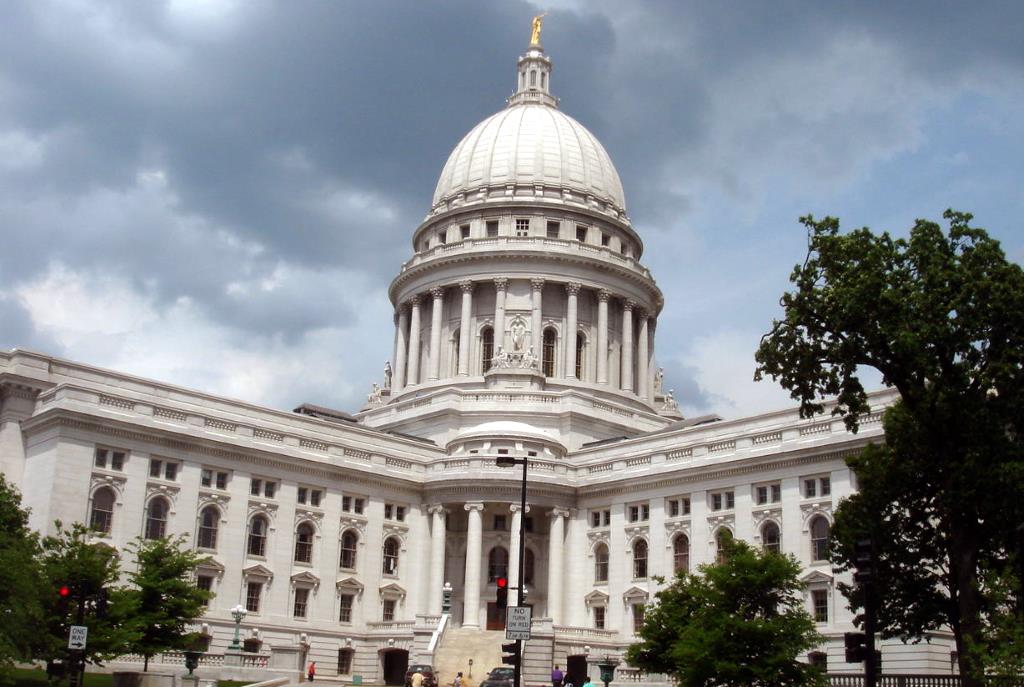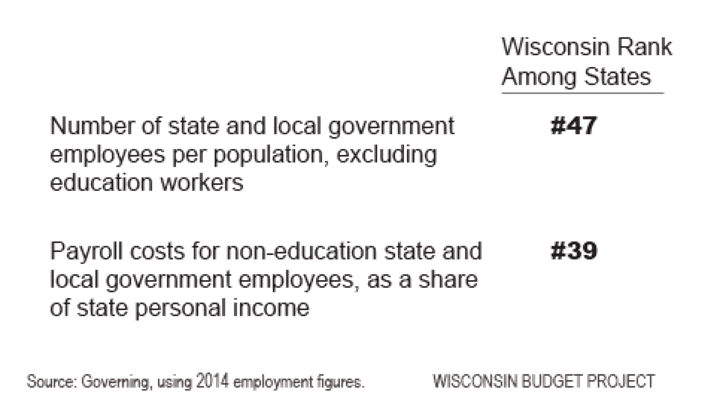Public Sector Costs Rank Below Most States
State ranks 47th in government employees per capita and 39th in payroll costs.
Wisconsin is leaner in most types of public sector jobs than all but a few other states, according to a review of employment figures by Governing.
Only three states have fewer public workers working in areas other than education than Wisconsin, according to the analysis. For every 10,000 state residents, Wisconsin has 199 public non-education employees. That’s less than half the number of public employees per population in Wyoming, which had the most public employees for its population size, and 50% less than the number of public employees per population in New York, Mississippi, and Alaska. Only three states had a smaller number of public employees than Wisconsin for their population size.
Wisconsin also ranked relatively low in payroll costs. For every $100,000 in personal income, Wisconsin governments spent $202 in March 2014 for non-education public employees. Only 11 states have lower payroll costs as a share of personal income.
Governing relied on U.S. Census Bureau figures from March 2014 for the analysis. Because the share of public workers working in education is significant, Governing looked at those workers separately from other public workers.
In K-12 education, Wisconsin ranks 35th highest among the states in the number of public workers for our population size, meaning that only 15 states have fewer K-12 education workers, and 27th in payroll costs per personal income. In higher education, Wisconsin ranks 14th highest among the states for the number of public employees, and 12th highest in their payroll costs as a share of personal income in the state, according to the analysis. One of the reasons that Wisconsin has more public employees working in higher education than most other states is that Wisconsin has a relatively high number of students attending public institutions. Wisconsin ranks 16th among the states in the number of students attending public two-year or four-year colleges for our size.
Earlier this year, the Wisconsin Budget Project reviewed the number of public employees in Wisconsin compared to other states. While we sliced the numbers a little differently, our analysis reached the same conclusion as the one in Governing: compared to other states, Wisconsin has relatively few public employees and low payroll costs.
Wisconsin Budget
-
Charting The Racial Disparities In State’s Prisons
 Nov 28th, 2021 by Tamarine Cornelius
Nov 28th, 2021 by Tamarine Cornelius
-
State’s $1 Billion Tax Cut Leaves Out 49% of Taxpayers
 Sep 21st, 2021 by Tamarine Cornelius
Sep 21st, 2021 by Tamarine Cornelius
-
TANF Program Serves a Fraction of Poor Families
 Aug 30th, 2021 by Jon Peacock
Aug 30th, 2021 by Jon Peacock
























If your findings are accurate the next step is to conduct a survey. Ask the government employees if they feel underpaid. If they feel underpaid we should do everything in our power to meet their satisfactions, right.
Seems to me like such a tight ship could impose difficulties when it comes to redundancies and knowledge transfer.
While the efficiency is certainly commendable, one has to wonder whether people’s passion and altruism are being exploited.
The thought apparently occurred to Jason. It is a valid thought. Are government workers any less entitled to fair compensation?
This is great news! Let’s keep it that way. Our public sector employees are obviously very efficient, and that benefits all of us by keeping more money in the private-sector economy, encouraging demand and job growth.
WashCoRepub, If that were the case then why aren’t we 2nd or even 11th in economic growth?
He likely won’t reply. He’s a troll. He shows up sporadically, repeats a GOP talking point, and rarely responds to questions. On the rare occasions he responds it’s GOP a talking point.
WashCoRepub, don’t worry, I got this!
You can do things to improve the environment for economic growth but you can’t force things to happen… plus there are still many factors working against Wisconsin.
So, you have no evidence that your economic theory works? No results backing it up? Huh…
I’m reminded of those Nigerian prince email scams, where they don’t actually try very hard to trick you. The scammers only want the truly gullible/ignorant/desperate to respond, rather than waste trying to convince a regular person who will undoubtedly figure out they’re being lied to, before committing any money.
“plus there are still many factors working against Wisconsin”
The governor and legislature. Way to stand up for trolls.
That’s exactly correct Tim.
Vincent, I did come to the defense of a Troll… but couldn’t resist… I have nothing to do during lunch today! I would agree the government and legislature is hindering economic growth… political uncertainty and unrest definitely has a dampening effect.
Tim, you’re statement is not true. The vast majority of peer reviewed studies show there is a negative relationship between taxes and economic growth. The best way to say it is that higher taxes have a negative impact instead of saying lowering taxes has a positive impact.
Part of the issue is that the economy is so complex, you can find data to support pretty much whatever position you want to take. However, if you look at the issue from the inside at a corporation making business decisions, the effects of higher/lower taxes is clearly visible.
AG, please show your studies… don’t be like WCD & tell me to “look it up”. Of course, 2 places that are exactly the same but 1 has lower taxes, all things being equal… the lower tax area will win. However, I’d be interested to read about your studies because usually it’s something like:
Area 1 has higher taxes, different institutions, governance, laws & workforce while area 2 has lower taxes & all the other differences. I tend to look at the outcomes… do high tax areas tend to be wealthier or poorer as a whole? What do I want my state & region to look like in the future… to do what the wealthier areas are doing or do what the poorer areas are doing?
Unfortunately duty calls so I don’t have the time at the moment… but I did my own quick googling like WCD would have told us to do, and found a good page from the Tax Foundation. They clearly align more with conservatives and are pro-business, but its’ a good read to get their perspective. I like it because they mention the same thing I did about a complex economy makes finding data to support your own beliefs possible for anyone… and they properly describe higher taxes as having negative impact instead of saying lowering has positive impacts… so they hooked me right there. 🙂
http://taxfoundation.org/article/what-evidence-taxes-and-growth
The gist of what I’m reading is that you acknowledge there isn’t a simple, clear answer to the question & I say yes, of course. Looking at the link, your source is talking extensively about rates between nations… which is different than the comparison I was looking at within the U.S. Hey, I’m game though… the mantra of austerity is foolish. You can’t cut your way to success.
http://www.theguardian.com/business/ng-interactive/2015/apr/29/the-austerity-delusion
Obviously, but I have to point this out… cutting taxes at the state level necessitates cutting services. What is cut affects the economic productivity of the state as well. Lowering taxes, caeteris paribus, makes a state more economic productive but if that’s at the expense of (for example) a quality education system, obviously the net change is negative for that state.
What state do you want WI to look like?
This is from two weeks ago. The Path to Prosperity is Blue – “Red states dominated by Republicans embrace cut and extract. Blue states dominated by Democrats do much more to maintain their investments in education, infrastructure, urban quality of life and human services — investments typically financed through more progressive state and local taxes. And despite what you may have heard, blue states are generally doing better.”
http://www.nytimes.com/2016/07/31/opinion/campaign-stops/the-path-to-prosperity-is-blue.html
Tim, I don’t think we’re that far off in our general beliefs on the topic that there needs to be a balance… rather I think it’s more a matter of degree. I think the difference in most people’s perspective comes from either a skepticism of government and the belief that it’s usually not very efficient vs those who inherently trust government to do what’s best and that they’ll do it in the best way possible (or some area in between).
I’d say even most conservatives, sans Libertarians, understand that once you take care of inefficiencies then the only thing you can do next is cut programs. From there they have to decide what’s important and, as you say, what do we want WI to look like? If I have one criticism of the right, it’s that they too often only look at the costs and don’t take time to fully review the benefits. (mass transit anyone?)
I think that story speaks to the impact of focusing only or excessively on cutting.
In other words, we’re severely understaffed, and the staff is sadly underpaid. Tell me something I didn’t know.
Interesting choice of metric for government employee pay. Who uses payroll cost as a percent of state personal income as a comparison point for pay? Apparently Wisconsin Budget Project, a left-wing partisan organization that is biased toward spending and taxing more in Wisconsin. That is why I am curious about their metrics and don’t trust WBP to provide honest, unbiased data.
If Wisconsin has less government employees (ranked 47), and payroll per personal income is ranked 39, does that mean pay per government employee is actually high in Wisconsin compared to most states? Also, what about benefits and cost of living in Wisconsin compared with other states? Both of these are large factors when someone chooses employment and is comparing pay packages for jobs in different states.
With respect to education spending, it appears we have above average pay for education workers. We may rank even higher in education payroll spending if cost of living is taken into account. Also, why isn’t education employees per state population under age 18 used? Are these metrics cherry picked? Again- because of WBP’s bias, anything being pushed by them should be carefully scrutinized, and readers should be concerned about being spoon fed data that supports their agenda.
As always, the Urban Milwaukee editors are unethically allowing a biased party to editorialize in a fake news article. Not real journalism, but real hypocrisy. Just look back to June when Bruce Murphy was complaining about Journal bias against Feingold.
Why not let the NRA post a weekly column about their cherry-picked facts regarding gun ownership? Or how about a pro-life organization publishing weekly statistics about their cherry-picked facts regarding abortions? Think that would happen in a legitimate news source if it were not identified as an editorial?
Finally, I am complaining about this because I would like to see Urban Milwaukee as a real new source about urban issues and policy with honest journalism and good, open debate. Milwaukee does not need another Shepherd Express.